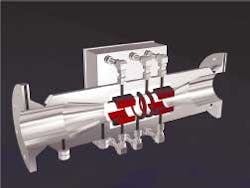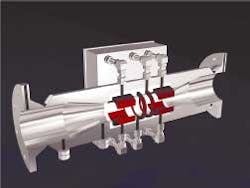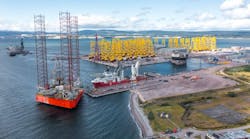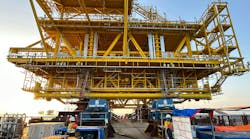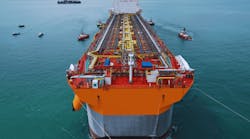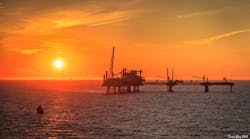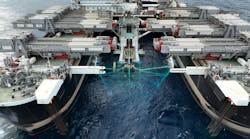William Furlow • Houston
New TLP design overcomes mating limits
In the choice between a TLP solution and a Spar, one of the major considerations has always been the cost of offshore mating. A conventional TLP is towed to an offshore well site upright, and then ballasted down to be locked off to the tendons. This means the topsides can be mated and commissioned dockside before the hull is taken offshore.
Because of its length, a Spar hull must be towed offshore on its side, ballasted to a vertical attitude, and anchored in place. Only then can the topsides modules be mated and the commissioning performed. While the cost to engineer and fabricate a Spar is less than a conventional, four-column TLP, the cost of mating and commissioning topsides offshore is higher.
Atlantia, makers of the SeaStar TLP, have found themselves in the middle of this dilemma. Their design is a minimal TLP with a single column, rather than the four seen on other TLP designs. The SeaStar is transported offshore in the vertical position and anchored in place as a traditional four-column TLP hull. But, because of its low center of buoyancy and small waterplane area, an advantage in a minimal design, the topsides must be mated and commissioned offshore.
The earlier versions of this design were for smaller fields where a single heavy lift could place the topsides. These topsides designs were similar to those seen on fixed-bottom jackets in conventional water depths. The costs and complexity of these types of installations were small enough to make the platform less expensive, despite the offshore mating and commissioning.
Now, with the 10,000-ton payload of the new Matterhorn platform (the first dry-tree SeaStar design), Atlantia is clearly competing head-to-head with conventional TLPs. The single-column hull is still simpler and less expensive to design and fabricate than a four-column TLP, but the offshore mating is approaching the limits of heavy-lift equipment in the Gulf of Mexico due to the larger, more complex topsides.
Increasing the size and weight of the topsides further would require multiple heavy lifts, meaning more risk and more complexity, which further increases costs. In addition to these considerations, in more remote areas it is sometimes difficult to secure a heavy lift vessel. It would be much simpler and less expensive to install a fully mated platform.
Using much smaller vessels, it would be possible to preinstall the anchor piles, freestanding tendons, and other equipment so that a self-installing platform could be towed to site and hooked up without the need for a heavy-lift vessel. Thus, the goal of the company's new design is a hull that can be mated quayside like a conventional TLP, but still maintain the simplicity and low cost of a mono-column design.
The limitations of the SeaStar are not its deckload or stability in transit. On previous installations, the SeaStar TLP has used a heavy-lift vessel to provide additional stability for some phases of submergence.
This requirement is now addressed by adding temporary buoyancy outboard of the pontoons to provide additional stability. These Temporary Buoyancy Modules are connected to the tips of the three pontoons using a standard latching mechanism. They can easily be installed at the dock and, once the platform is securely in place, the TBMs can be removed. Because the tanks are located outboard of the pontoons, they are off the critical path and do not interfere with any other operations.
According to the new design, these tanks would be installed quayside, used during the platform installation, and then removed once the platform is in place. By using TBMs, Atlantia's SeaStar can be installed with the topsides already completed.
This design would also allow the TLP to be relocated without removing the topsides, another advantage over Spar and other SeaStar designs. The design has been completed for Atlantia's third-generation SeaStar, which incorporates this new installation method as well as a much larger-diameter hull accommodating a payload of 30,000 tons.
The design package has been sent to a number of fabrication yards worldwide for construction cost estimates. Atlantia envisions this new design will be applicable not only for hub facilities in the Gulf of Mexico, but also for remote projects offshore West Africa and Southeast Asia.
Multiphase flow meter completes field trials
Halliburton Energy Services has completed field trials in Algeria of its non-radioactive multiphase flow meter system – FastQ. The skid-mounted system measures the flow rates of oil, water, and gas continuously without mixing or separating of fluids.
The flow meter system is used for exploration and production well testing, production monitoring, and allocation metering. It is free of radioactive sources and has been successfully tested at independent flow test laboratories in Norway and the UK.
null
The FastQ system gives the global customer a highly accurate, non-radioactive solution for multiphase measurement, using a proven method of mass measurement.
Weatherford to install Gunnison riser
Weatherford will perform the production riser installation on the Gunnison spar wells for Kerr-McGee. The Gunnison truss spar will be installed in 3,150-ft water depth in Garden Banks block 668 of the Gulf of Mexico. The first riser installation is scheduled for 4Q 2003.
Kerr-McGee plans seven dry-tree wells. All risers will be installed using Weatherford's Stabberless System, described by Weatherford as a hazard-reducing means of running casing and tubing that lowers costs and increases safety. The top tension, single barrier riser design is similar to the risers Weatherford recently installed on the Nansen and Boomvang spars for Kerr-McGee.
BJ lands pipeline pre-commissioning contract
Stolt Offshore Services S.A. awarded BJ Process and Pipeline Services a multi-million dollar contract to provide pipeline pre-commissioning services on several sections of Shell Petroleum Development Co.'s new offshore gas gathering system in Nigeria. During the coming months, BJ PPS will provide flooding, cleaning, gauging, hydrotesting, de-watering, air-drying and nitrogen packing services on the system's 32-in. trunkline, 24-in. spurline, and 16-in. spurline.
The first phase of the project, which has begun, is to pre-commission the 32-in. trunkline. BJ PPS has successfully flooded, cleaned, and gauged the offshore section of this trunkline. These services are being carried out both on and offshore. The pipeline will be tied in to the unmanned RP-A platform, 18 km west-southwest of South Forcados, where BJ PPS will work from a support vessel alongside the platform. This trunkline runs 268 km southeast along the Nigerian coast to Bonny Island, where it reaches the shore.
Phase II involves the pre-commissioning of the 24-in. spurline that lies between the RP-A platform and Forcados Yokri, 88 km north of the RP-A. The third and final phase is to pre-commission the 16-in. spurline between the RP-A and South Forcados, which measures 18 km. Both Phase II and III will be carried out from a support vessel positioned alongside the RP-A, and on the respective beaches at Forcados Yokri and South Forcados. BJ PPS will leave the pipeline on the beach sealed, following completion of all related pre-commissioning services.
